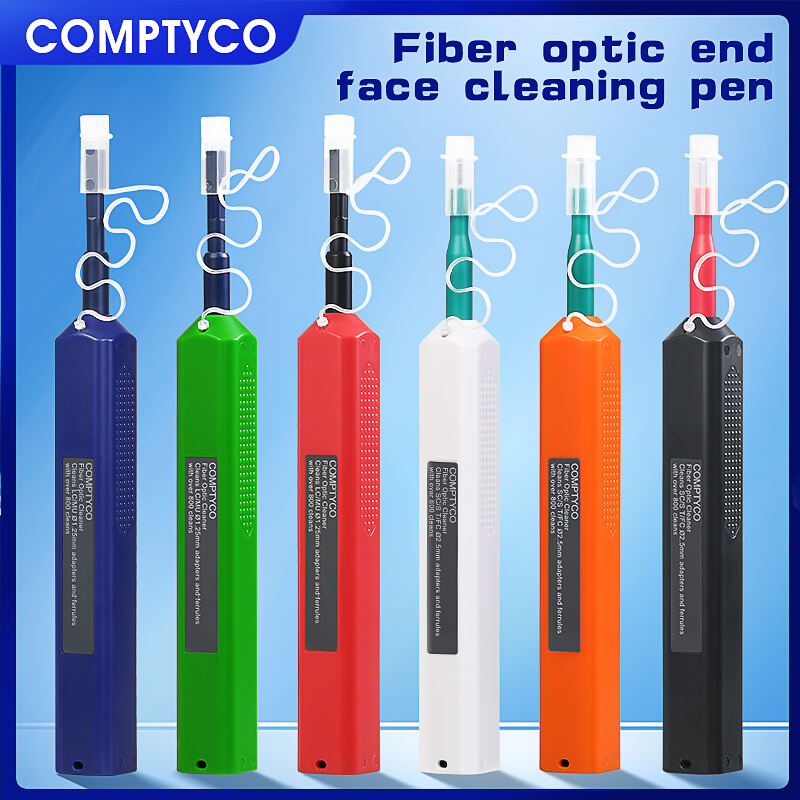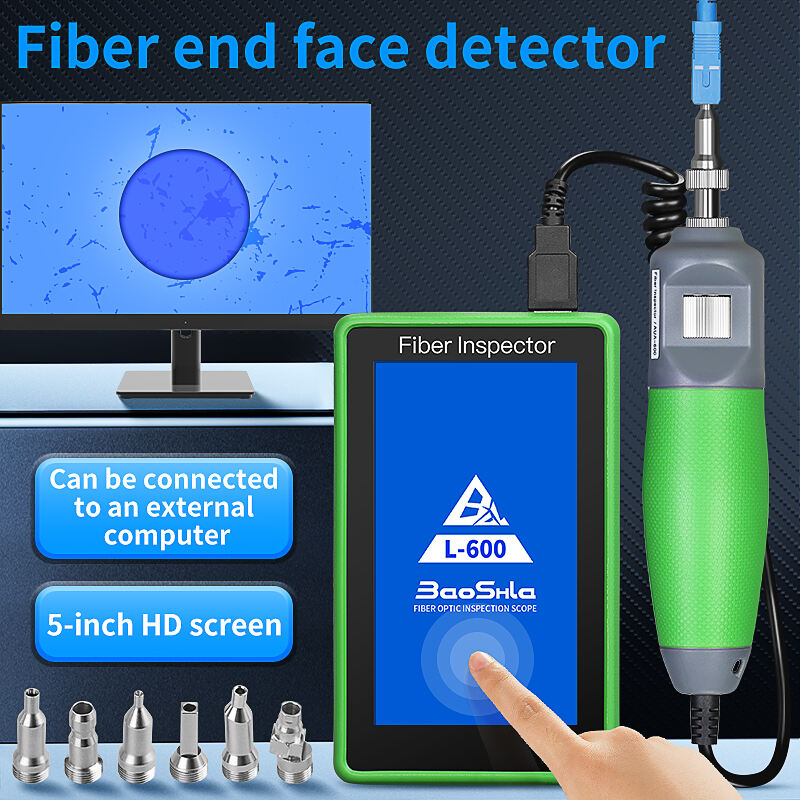पेशेवर फाइबर ऑप्टिक रखरखाव के माध्यम से श्रेष्ठ प्रदर्शन बनाए रखना
आज की उच्च-गति वाली डिजिटल दुनिया में, फाइबर ऑप्टिक नेटवर्क वैश्विक संचार की रीढ़ हैं। फिर भी, इनके प्रदर्शन का आधार एक महत्वपूर्ण रखरखाव पहलू पर होता है जिसे अक्सर नजरअंदाज कर दिया जाता है - उचित सफाई। फाइबर ऑप्टिक क्लीनर का नियमित रूप से उपयोग करना केवल एक सुझाव नहीं है; यह नेटवर्क के इष्टतम प्रदर्शन को बनाए रखने और महंगी डाउनटाइम से बचने के लिए आवश्यक है। यहां तक कि सूक्ष्म धूल के कण या उंगलियों के निशान भी सिग्नल की गुणवत्ता को काफी हद तक खराब कर सकते हैं, जिससे नियमित सफाई को नेटवर्क रखरखाव प्रक्रियाओं का एक महत्वपूर्ण हिस्सा बना दिया गया है।
दूषित फाइबर कनेक्शन के कारण दूरसंचार उद्योग प्रतिवर्ष लाखों का नुकसान उठाता है। मात्र 1/1000वें मिलीमीटर मापने वाली धूल की एक छोटी सी गंदगी प्रकाश संचरण का लगभग 1% तक अवरुद्ध कर सकती है - जो नेटवर्क में समस्या पैदा करने के लिए पर्याप्त है। यह वास्तविकता यह दर्शाती है कि गुणवत्तापूर्ण सफाई सामग्री में निवेश करना और उचित रखरखाव दिनचर्या स्थापित करना नेटवर्क की विश्वसनीयता के लिए कितना महत्वपूर्ण है।
फाइबर ऑप्टिक रखरखाव के लिए आवश्यक उपकरण और सामग्री
पेशेवर सफाई उपकरण चयन
सही का चयन फाइबर ऑप्टिक क्लीनर विभिन्न उपलब्ध उपकरणों को समझने के साथ शुरू होता है। आधुनिक सफाई किट में आमतौर पर फाइबर ऑप्टिक्स के लिए विशेष रूप से डिज़ाइन किए गए विशेष वाइप, स्वैब और सफाई घोल शामिल होते हैं। ये उपकरण संवेदनशील फाइबर सिरों पर अवशेष छोड़े बिना या उन्हें नुकसान पहुँचाए बिना प्रदूषकों को हटाने के लिए बनाए गए होते हैं। एक प्रोफेशनल-ग्रेड सफाई किट में फुसकुड़ी-मुक्त वाइप, विशेष सफाई घोल और स्वच्छता की पुष्टि करने के लिए निरीक्षण उपकरण शामिल होने चाहिए।
किसी भी सफाई किट का आधार फाइबर ऑप्टिक क्लीनर पेन या कैसेट क्लीनर होता है। ये उपकरण प्रभावी ढंग से अशुद्धियों को हटाने के लिए विशेष रूप से डिज़ाइन किए गए रिबन या कपड़े का उपयोग करते हैं। सफाई उपकरण चुनते समय, उन उपकरणों का चयन करें जो उद्योग के मानकों को पूरा करते हों और प्रमुख फाइबर ऑप्टिक उपकरण निर्माताओं द्वारा अनुशंसित हों।
उन्नत सफाई समाधान और विलायक
उपयोग किए जाने वाले सफाई घोल का प्रकार सफाई प्रक्रिया की प्रभावशीलता को काफी प्रभावित कर सकता है। फाइबर ऑप्टिक्स के लिए विशेष रूप से तैयार उच्च-ग्रेड आइसोप्रोपिल अल्कोहल घोल उद्योग मानक हैं। ये घोल उचित उपयोग करने पर तेजी से वाष्पित हो जाते हैं और कोई अवशेष नहीं छोड़ते। हालाँकि, केवल विशेष फाइबर ऑप्टिक सफाई घोल का ही उपयोग करना महत्वपूर्ण है, क्योंकि सामान्य अल्कोहल या सामान्य उद्देश्य वाले सफाई घोल हानिकारक अवशेष छोड़ सकते हैं।
आधुनिक सफाई घोल अक्सर साफ की गई सतह पर धूल के आकर्षण को रोकने के लिए एंटी-स्टैटिक गुण शामिल करते हैं। इस नवाचार ने सफाई परिणामों के लंबे समय तक बने रहने में काफी सुधार किया है और आवश्यक रखरखाव की आवृत्ति को कम कर दिया है।
पेशेवर सफाई तकनीक और सर्वोत्तम प्रथाएँ
उचित सफाई विधियाँ और प्रक्रियाएँ
फाइबर ऑप्टिक सफाई की सफलता केवल उपयोग किए गए उपकरणों पर निर्भर नहीं करती, बल्कि लागू की गई तकनीक पर भी निर्भर करती है। हमेशा इस उद्देश्य के लिए डिज़ाइन किए गए फाइबर ऑप्टिक क्लीनर का उपयोग करके शुष्क सफाई प्रयास से शुरुआत करें। यदि संदूषण बना रहता है, तो उपयुक्त विलयनों का उपयोग करके गीली सफाई की ओर बढ़ें। सफाई की गति हमेशा एकदिशीय होनी चाहिए - कभी भी आगे-पीछे नहीं, क्योंकि इससे संदूषक पुनः वितरित हो सकते हैं या खरोंच हो सकती है।
सफाई प्रक्रिया शुरू करने से पहले, फाइबर माइक्रोस्कोप या निरीक्षण स्कोप का उपयोग करके फाइबर अंत-सतह का निरीक्षण करें। यह प्रारंभिक निरीक्षण संदूषण के प्रकार और गंभीरता की पहचान करने में मदद करता है, जिससे आवश्यक सफाई दृष्टिकोण का निर्धारण होता है। सफाई के बाद, हमेशा पुनः निरीक्षण करें ताकि सुनिश्चित हो सके कि सभी संदूषक हटा दिए गए हैं।
पर्यावरणीय विचार और सुरक्षा उपाय
सफाई का कार्य जिस वातावरण में किया जाता है, वह स्वच्छता बनाए रखने में एक महत्वपूर्ण भूमिका निभाता है। अत्यधिक धूल या वायु में उड़ने वाले कणों से मुक्त अच्छी तरह से वेंटिलेटेड क्षेत्र में काम करें। सफाई घोल या निरीक्षण उपकरण के साथ काम करते समय विशेष रूप से आँखों की सुरक्षा सहित उपयुक्त व्यक्तिगत सुरक्षा उपकरण का उपयोग करें।
तापमान और आर्द्रता सफाई की प्रभावशीलता और सफाई घोल के प्रदर्शन को प्रभावित कर सकते हैं। संभव होने पर एक नियंत्रित वातावरण बनाए रखें, और सफाई सामग्री को निर्माता की सिफारिशों के अनुसार संग्रहित करें ताकि उनकी प्रभावशीलता बनी रहे।

रखरखाव निर्धारण और दस्तावेजीकरण
प्रभावी सफाई निर्धारण विकसित करना
नियमित रखरखाव निर्धारण उनके होने से पहले प्रदर्शन संबंधी समस्याओं को रोकने के लिए आवश्यक हैं। पर्यावरणीय स्थितियों, नेटवर्क उपयोग और निर्माता की सिफारिशों के आधार पर सफाई अंतराल निर्धारित करें। उच्च यातायात वाले या कठोर वातावरण वाले स्थापनों को नियंत्रित वातावरण में स्थापित उपकरणों की तुलना में अधिक बार सफाई की आवश्यकता हो सकती है।
प्रत्येक सफाई सत्र के बारे में विस्तृत रखरखाव लॉग तैयार करें, जिसमें तारीख, तकनीशियन, उपयोग की गई विधियाँ और देखे गए परिणाम शामिल हों। इस दस्तावेज़ीकरण से सफाई की प्रभावशीलता को ट्रैक करने और उन पैटर्न की पहचान करने में मदद मिलती है जो ध्यान देने योग्य मुद्दों का संकेत दे सकते हैं।
प्रदर्शन निगरानी और गुणवत्ता आश्वासन
नेटवर्क संचालन को प्रभावित करने से पहले संभावित स्वच्छता समस्याओं का पता लगाने के लिए नियमित प्रदर्शन निगरानी लागू करें। इसमें नियमित संकेत शक्ति माप और अंतिम सतह निरीक्षण शामिल हैं। आधुनिक नेटवर्क निगरानी उपकरण धीमी गति से हो रहे प्रदर्शन में गिरावट की पहचान करने में मदद कर सकते हैं जो यह दर्शा सकते हैं कि सफाई की आवश्यकता है।
गुणवत्ता आश्वासन प्रक्रियाओं में सफाई तकनीकों और उपकरणों के नियमित मूल्यांकन शामिल होने चाहिए। अवधि-अवधि पर सफाई प्रोटोकॉल की समीक्षा करें और फाइबर ऑप्टिक क्लीनर तकनीक में नए उद्योग सर्वोत्तम अभ्यासों या तकनीकी विकास के आधार पर उन्हें अपडेट करें।
अक्सर पूछे जाने वाले प्रश्न
ऑप्टिकल फाइबर कनेक्शन की सफाई कितनी बार करनी चाहिए?
फाइबर ऑप्टिक कनेक्शन को हर बार अनमैट करने पर और नए कनेक्शन बनाने से पहले साफ करना चाहिए। इसके अतिरिक्त, पर्यावरणीय स्थितियों और उपयोग प्रतिरूपों के आधार पर नियमित रूप से सफाई करनी चाहिए, आमतौर पर साफ वातावरण में स्थिर कनेक्शन के लिए हर 3-6 महीने में।
अगर फाइबर ऑप्टिक कनेक्टर्स को ठीक तरह से साफ नहीं किया जाता है तो क्या होता है?
गंदे कनेक्टर्स सिग्नल नुकसान, बिट त्रुटि दर में वृद्धि और नेटवर्क प्रदर्शन संबंधी समस्याएं पैदा कर सकते हैं। गंभीर मामलों में, दूषित कनेक्टर्स के अंतिम भागों को स्थायी रूप से नुकसान पहुंचा सकता है, जिससे घटकों को महंगे दामों पर बदलने की आवश्यकता हो सकती है।
क्या मैं फाइबर ऑप्टिक कनेक्टर्स को साफ करने के लिए सामान्य अल्कोहल का उपयोग कर सकता हूं?
नहीं, सामान्य अल्कोहल का कभी भी उपयोग नहीं करना चाहिए। केवल विशेष फाइबर ऑप्टिक सफाई समाधान का उपयोग किया जाना चाहिए, क्योंकि वे बिना किसी अवशेष छोड़े वाष्पित होने के लिए विशेष रूप से तैयार किए जाते हैं और संवेदनशील फाइबर ऑप्टिक सामग्री को नुकसान नहीं पहुंचाते हैं।







